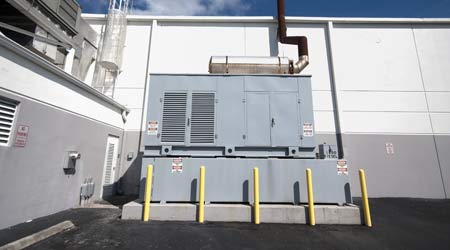What Is The Purpose of Prime Onsite Power Generation?
Here's what you need to know about reducing utility costs with prime onsite power generation.
Generally, the main purpose for prime onsite power generation is to reduce utility power costs. A secondary and increasingly important purpose is to reduce carbon footprint, if the onsite power production is cleaner than the generation mix provided by the utility.
Prime onsite power generation is also needed in remote locations with no utility power available, or where the available utility power feeds or the supporting grid are undersized and cannot be quickly or cost-effectively upsized. Data centers and other large power-demanding construction projects sometimes face this challenge.
Prime power has also been cost-effective in limited cases with large, onsite gas turbines or small micro-turbines, especially when the otherwise wasted heat is re-purposed for other uses in the facility. This is commonly known as co-generation (co-gen) or combined heat and power (CHP). However, using most of the heat year-round to offset some of the cost of operating other heat sources (gas-fired boilers, etc.) often proves difficult. Using the waste heat to reliably produce cooling with absorption or adsorption chillers can be challenging. Diesel engines are rarely deployed in co-gen or CHP applications.
Some technologies — such as photovoltaic (PV) solar, gas turbines, and fuel cells — are almost exclusively deployed as prime power, supplementing or replacing utility power, rather than as backup power. Unless enhanced, these high-impedance “soft” source technologies are better suited to steady, base loads than to changing loads requiring a stiff source.
In most onsite prime power applications, the onsite power operates connected to and in parallel with the utility source. Both the utility and onsite power generation are electrically coupled and share the load. The utility can provide startup/inrush current when needed. Control systems limit the onsite source contribution to prevent overloading the generator and may also limit reverse power flow back to the utility. Reverse power flow can occur if onsite power generating capacity exceeds the onsite load.
In some cases, utility power is used as a backup source to add reliability. In these cases, the onsite power generating systems operate in a stand-alone “islanding” mode. When islanding, a prime generating source provides all of the power to the facility, and utility power, if available, is disconnected from the facility. In some islanding applications, the traditional generator automatic transfer switch application is reversed: The onsite prime power source is “normal” and the utility source is “emergency” backup.
In onsite prime power applications, automatic switchgear and control systems typically determine whether conditions are favorable to operating onsite generation equipment in parallel mode, islanding mode, or simply shutting it down, and then take action so that equipment runs in the appropriate mode. Additional reliability can be gained by adding traditional standby diesel or gas engines for backup power.
Although it may be counterintuitive, most onsite prime power generation operates more stably when paralleled with the utility than when islanded. The utility grid is a very stiff source with large rotating inertia that maintains voltage and rock-solid frequency. And if the facility has appropriate safeguards installed, most utilities will allow parallel operation and even credit reverse power flow, acting as a battery for the facility.
Keep in mind that most gas generator, turbine, and fuel cell prime power deployments effectively replace one utility, which has largely above-ground transmission and distribution, with another utility (natural gas), which has largely more reliable underground transmission and distribution. Natural gas increasingly can be stored onsite, but costs, runtime limitations, space requirements, and other challenges exceed those of diesel fuel storage.
One significant difference with gas generators and turbines compared to fuel cells is that the generators and turbines burn the fuel and produce harmful emissions. Therefore air-quality management districts in large urban areas present similar challenges to permitting gas and diesel engines. Fuel cells don’t burn the fuel; fuel cells use an electrochemical process producing minimal harmful emissions, aside from carbon dioxide, which fuel cells do produce.
Related Topics:
















